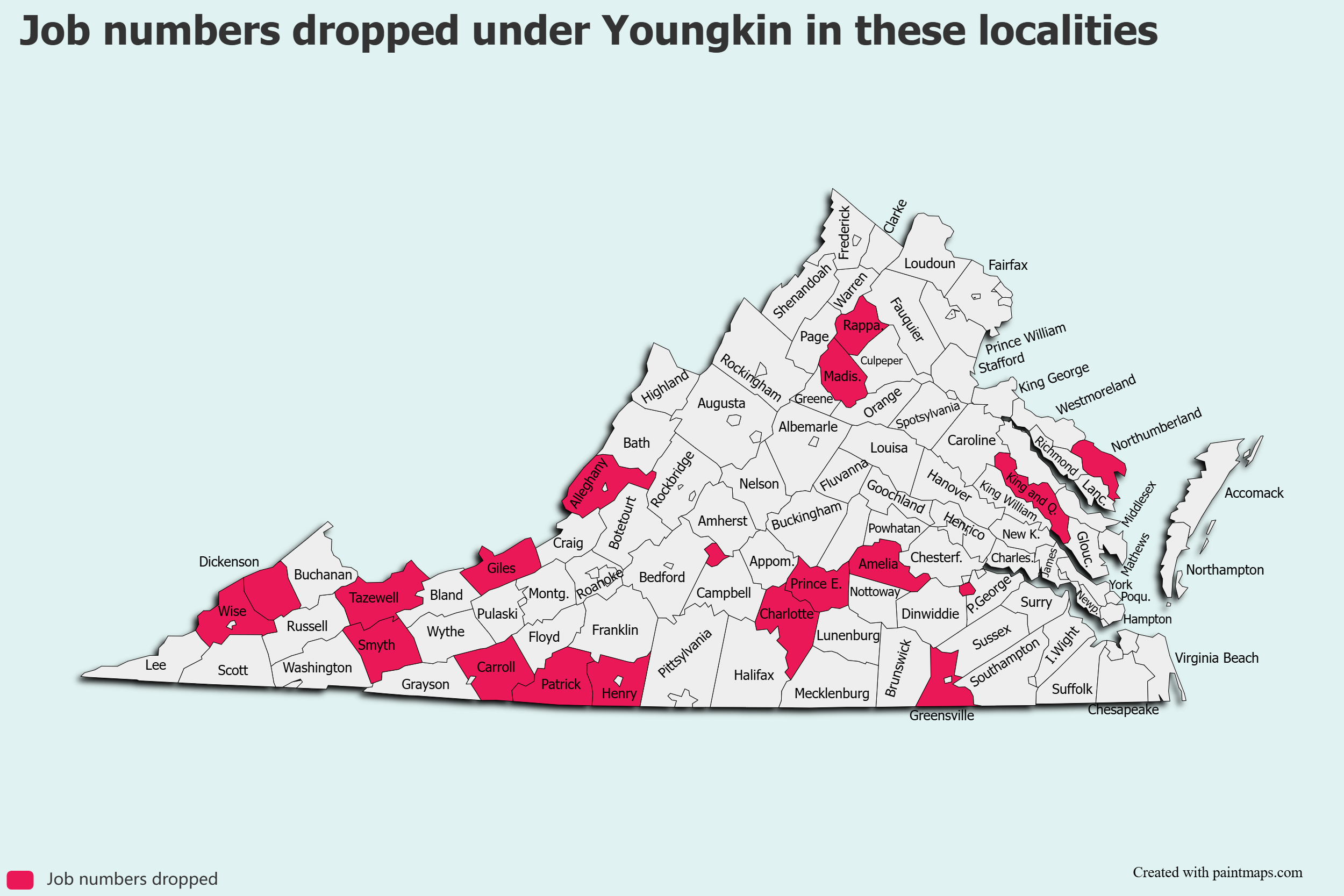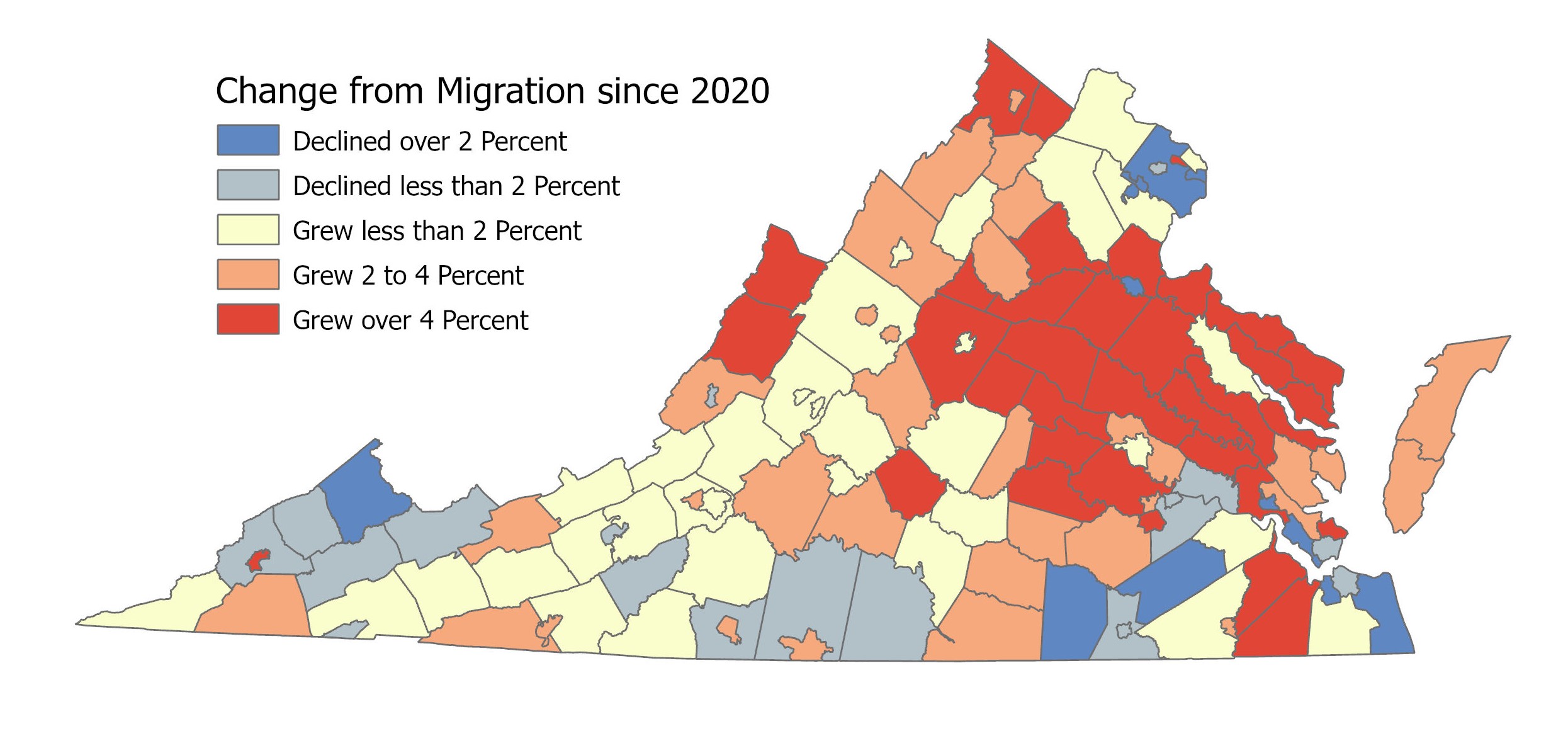When Glenn Youngkin ran for governor in 2021, he promised a “rip-roaring economy,” which is one of the best adjectives ever.
So how’s he done?
The question seems particularly relevant now that it’s another election year and part of the Republican argument for Winsome Earle-Sears is the “keep a good thing going” pitch. Another part is that under Abigail Spanberger, Democrats would do things that would hurt the Virginia economy, such as change the state’s “right-to-work” law that bans compulsory payment of union dues by non-union members if there’s a union in the workplace. Spanberger says she opposes a “full repeal” but hasn’t said what kind of “partial repeal” she might support. (See more about that the candidates have to say about these and other topics in our Voter Guide.)
Economics has earned the nickname “the dismal science,” but the beauty of it is that most things in the economic realm can be quantified, so let’s see what the numbers tell us here.
Before we begin, we have to issue a mighty big caveat: Governors don’t unilaterally control a state’s economy. They all have to operate within the context of both national and global trends. For instance, Youngkin has governed during a time when inflation shot up to 9.1% early in his term. That wasn’t his fault, but he had to deal with the consequences, just like now he has to deal with the consequences of President Donald Trump’s tariffs. With that, let’s crack open the numbers and see where they lead us.
More jobs added under Youngkin than anytime in past three decades
Governors love to announce new jobs, and Youngkin has had jobs to announce. When he took office in January 2022, Virginia had 4,004,600 jobs. By June 2025, we had 4,268,300, according to the Federal Reserve. That’s an increase of 263,700, and I’m sure if Youngkin could have been there to cut the ribbon on all of them, he would have been.
We need context, though, so here it is.
His predecessor, Ralph Northam, had the misfortune to be in office when the pandemic hit, and that certainly messed things up economically. The Federal Reserve says the state added just 13,600 jobs during his term.
Before him was Terry Auliffe. Virginia saw 178,500 new jobs during his term.
Before McAuliffe was Bob McDonnell, who ran for office on the slogan of “Bob’s for Jobs” — a catchy phrase but also a powerful one as we were coming out of the recession in 2009. Under him, Virginia added 195,900 jobs.
Here’s what happens when you’re governor during a recession: Tim Kaine saw the state lose 97,700 jobs during his term.
For those who want to go back further, here’s how every governor since 1990 has done (which conveniently matches up with the dataset the Federal Reserve has available:
Now, there are some who will look at this list and conclude that more jobs get created under Republican governors than Democratic ones. Others will look at this and conclude that some Democratic governors have just had bad timing. Mark Rozell, dean of the Schar School of Policy and Government at George Mason University, warned in an opinion piece in the Richmond Times-Dispatch this week that Virginia’s next governor will face economic pain due to the impact of tariffs and federal job cuts. If that next governor happens to be Spanberger, she could be the latest in a line of Democrats to preside over troubled times that make economic growth difficult to achieve. Either way, here are the pertinent numbers: More jobs have been added under Youngkin than at any time since George Allen was governor from 1994 to 1998 — and he could yet top that. Democrats might say that was really Joe Biden’s economy and Youngkin was just living in it but, for our purposes here in Virginia, all these jobs have been created under Youngkin’s watch. If that qualifies in your book as “rip-roaring,” well, there’s the rip and the roar.
Now before Republicans celebrate too much, let’s add some more context.
Virginia’s job growth has slowed each year
Youngkin’s best year was his first one. Each year afterward, job growth in the state has slowed. Many economic development deals are years in the making, so it’s hard to say how many of the jobs in Youngkin’s first year can be attributed to his policies and how much just to being in the right place at the right time. In 2022, we were coming out of the pandemic and the economy was returning to normal. That could account to the big burst in 2022 and the slowdown thereafter. So could inflation that ran rampant nationally.
2022: 123,700
2023: 96,900
2024: 64,500
2025 year to date: 47,800
Sharp-eyed observers (or those with a calculator) will notice these numbers add up to 332,900 jobs, distinctly more than the 263,700 cited above. I don’t have a good explanation for the discrepancy other than to point out they come from different sources: These numbers, compiled by Arizona State University, come from the Bureau of Labor Statistics. The ones cited previously come from the Federal Reserve.
Perhaps what we need is more context. Conveniently, we have it.
Virginia improved job growth relative to other states
If the supposition above is true, then other states would have been affected by the same trends, so maybe the best measure isn’t whether our job growth has gone up or down, but how it’s performed relative to other states.
Here’s what we see, courtesy of the Bureau of Labor Statistics:
In 2021, before Youngkin took office, Virginia trailed most other states. We ranked just 39th.
In 2022, Youngkin’s first year, and the year with the most job growth, Virginia still trailed most other states but we moved up to 33rd.
In 2023, as Virginia’s job growth slowed, the state improved relative to other states — we ranked 17th for the rate of job growth. On a percentage basis, our job growth was also higher than the national average.
In 2024, as Virginia’s job growth slowed even more, we still improved relative to other states — ranking ninth in the country. Once again, our job growth was higher than the national average.
So far in 2025, we’ve slipped back to 18th — and slower than the national average.
At the risk of sounding like a Youngkin cheerleader, if we’re going to ascribe any credit or blame to a governor on the economy, we have to give Youngkin high marks here. He took over an economy where job growth was near the bottom nationally and took it into the Top 10. Something caused that to happen. Maybe it was simply Virginia’s good looks and charm — or our natural attributes of one of the world’s largest natural harbors and other economic assets. However, if our governor had anything to do with job growth, it must have been on the positive side.
As for that slide this year, it’s possible, perhaps even likely, that’s Trump’s doing — a combination of federal job cuts and the impact of tariffs. Virginia is an export-driven state, so anything that discourages exports (such as retaliatory tariffs imposed by other countries) is bound to slow Virginia’s economy.
The ranking I’m discounting
For our purposes today, I’m disregarding CNBC’s annual “best state for business” rankings. That’s something Youngkin touted when we were No. 1 and talked down when we weren’t. The reality: CNBC changes the scorecard every year, as I discussed in an earlier column. It’s also clear that Trump’s downsizing of the federal government has pulled Virginia down. You can blame Youngkin, if you want, for not criticizing Trump, but ultimately that’s a Trump policy, not a Youngkin policy. I’d also rather stick to actual numbers than somebody else’s weighting and ranking of those numbers, no matter what they show. So back to those numbers:
Virginia’s job growth has been uneven

This is hardly a surprise, but it is a fact. Unfortunately for our purposes, the figures for individual localities lag well behind the statewide data, so the figures I’m about to present are about six months old but appear to be the most recent available. Of Virginia’s 133 counties and cities, 114 saw the number of jobs increase during Youngkin’s time in office. However, 19 saw their job counts drop. Almost all were in Southwest and Southside. Is Youngkin to blame for those? I’d say no. Those rural counties face economic (and demographic) challenges that would bedevil any Virginia governor. It’s certainly fair to argue, if you want, that any particular governor hasn’t done enough for rural Virginia, but I’m not sure how you measure that. What would an alternative approach have yielded in those 19 localities? We have no way of knowing, we just know their job counts went down. The modern economy simply favors an Arlington County over a Buchanan County. That’s not something any governor — or any president, for that matter — can fix.
Virginia’s population exodus has stopped under Youngkin

With the exception of 2013, Virginia had consistently seen net out-migration — more people moving out than moving in. Now that’s been reversed — more people are moving in than moving out. The biggest reversal has come in rural areas, most of which more see more in-migration than out-migration. (If they’re still losing population, it’s simply because, with an older population, deaths overwhelm everything else, statistically speaking.) Youngkin claims credit for this turnaround. Feel free to debate whether he had anything to do with that or not, but it would seem the economy certainly had something to do with it, so if he’s responsible for part of the economy he should at least get some of the credit. People really do “vote with their feet,” and now they’re voting in Virginia’s favor. Does all this mean we now have a “rip-roaring” economy? That may be a more subjective matter, but it is one that is attracting people when before it wasn’t. That seems a check box on the plus side. There is one other measure I’d like to consult.
Virginia consistently underperforms North Carolina
Virginia borders five states, plus the District of Columbia, but the ones that matter most for those of us in Southwest and Southside are North Carolina and Tennessee. The latter may or may not be a fair comparison simply because of geography; the most distant parts of North Carolina are still pretty close to us, but the most distant parts of Tennessee aren’t. Let’s just look at North Carolina, with whom we share our longest border.
North Carolina consistently outperforms Virginia in job growth — more jobs, faster job creation, higher rankings relative to other states. This has been the case for a long time, no matter who the governor is.
This might become a question for the next governor: Does that matter? Why or why not? And if it does, what should we do about it?
Want more politics? Sign up for West of the Capital, our weekly political newsletter:



